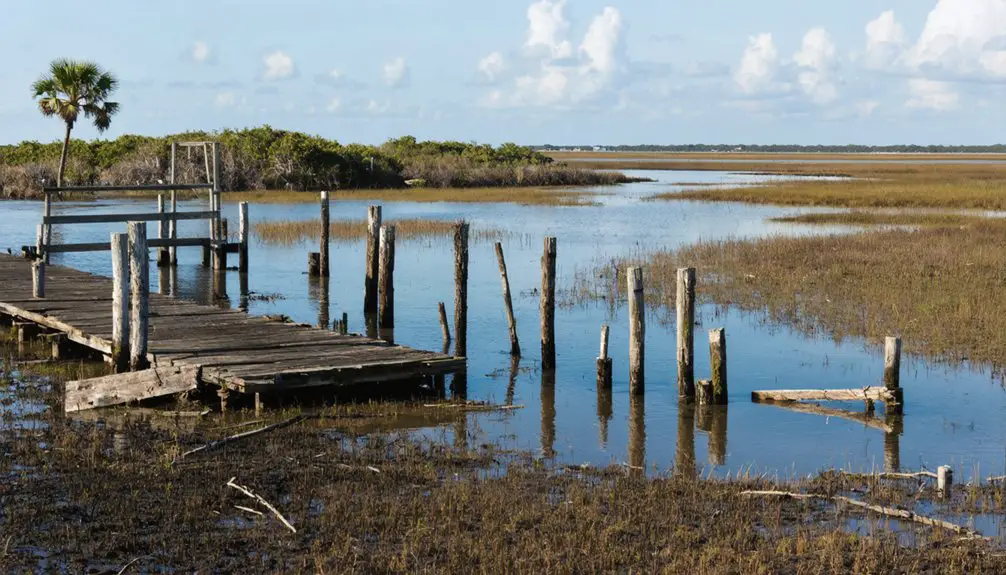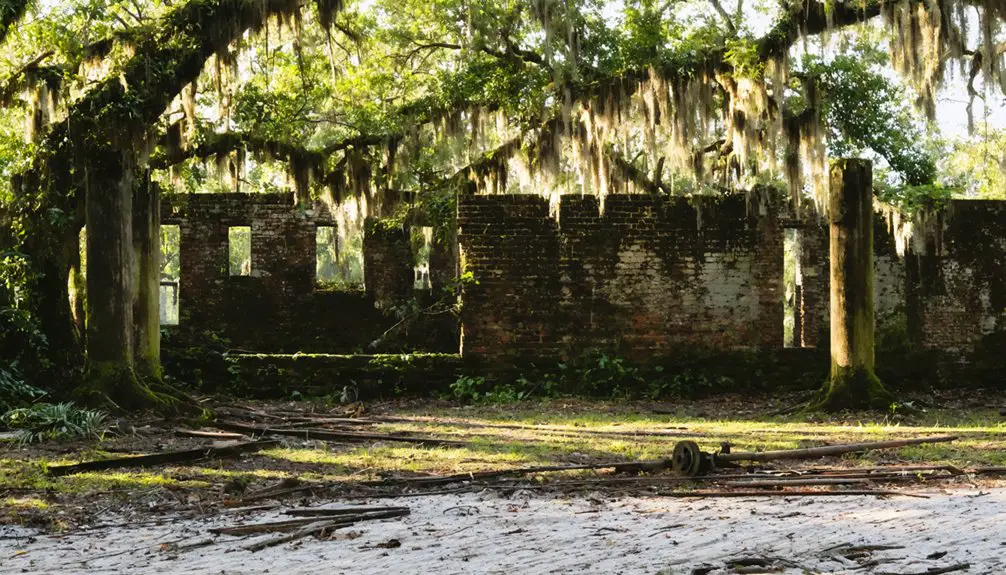You’ll find Greenbay’s abandoned ruins between Agricola Road and Bonnie Mine Road in Polk County, Florida, established in 1907 as a phosphate mining community. The town once bustled with workers, medical facilities, and rail connections before its decline. Today, dense vegetation has reclaimed the deteriorating buildings and mining remnants, while environmental scars from extensive phosphate operations persist across the altered landscape. This ghost town’s complex story reflects Florida’s broader industrial heritage and environmental challenges.
Key Takeaways
- Greenbay is an abandoned phosphate mining town in Polk County, Florida, established in 1907 and located between Agricola and Bonnie Mine Roads.
- The town developed as a self-contained mining community with worker housing, medical facilities, and rail connections to neighboring areas.
- Environmental damage from phosphate mining, including radioactive waste and altered terrain, contributed significantly to the town’s abandonment.
- The site currently features deteriorating buildings, graffiti, and vandalism, with most areas restricted from public access since the 1970s.
- Native vegetation has reclaimed much of the area, though mining contamination continues to affect soil quality and plant growth.
Location and Geography
Greenbay, Florida’s precise location sits at approximately 27°50.2’N latitude and 81°55.5’W longitude in Polk County, nestled between Agricola Road and Bonnie Mine Road along State Road 640.
Located at 27°50.2’N, 81°55.5’W, Greenbay sits in Polk County between Agricola Road and Bonnie Mine Road along SR-640.
You’ll find this ghost town north of Fort Meade, accessible by taking US Route 17 north to Homeland, then heading west on Homeland Road (640).
The town’s geographic features reflect central Florida’s characteristic flat terrain, shaped by years of phosphate mining activity. The area shares similar mining heritage with Brewster power plant remnants just a few miles away.
Like many abandoned settlements in Florida’s history, the site provides valuable insights into the state’s development patterns.
The climate conditions include hot summers and mild winters, with high humidity year-round.
You’ll encounter dense vegetation that’s reclaimed much of the abandoned settlement, including saw palmettos and scrub pines that have overtaken any remaining structural foundations.
The surrounding landscape showcases the region’s rural character, typical of Florida’s phosphate mining districts.
Historical Origins
Greenbay’s origins can be traced to 1907 when phosphate mining companies established operations in this remote area of Florida.
You’ll find that the settlement grew rapidly as the mining company constructed worker housing, essential services, and basic infrastructure to support its isolated workforce.
The town’s development was heavily influenced by the limited transportation routes of the era, which necessitated the creation of a self-contained community where workers could live within walking distance of the mines.
Similar to Fort Howard Hospital, the mining operation included medical facilities to care for injured workers, though no paranormal activity was ever reported there.
Like the historic Florida East Coast Railroad that served other small Florida communities, Greenbay relied on rail transport for its connection to neighboring towns.
Mining Industry Settlement Growth
Following the discovery of phosphate in Florida in 1881, the region that would become Greenbay emerged as a significant mining settlement during the late 19th century.
The settlement dynamics reflected the rapid influx of workers, including African Americans and immigrants, who sought opportunities in the burgeoning phosphate industry. You’ll find that as mining operations expanded, the town grew to accommodate not just the mines but also supporting businesses and essential services. The industry’s economic impact grew substantially, becoming a multi-billion dollar sector that would shape Florida’s development for generations to come. The Greater Tampa Bay region became one of the most significant areas for phosphate extraction in the state.
Labor movements gained traction as workers faced challenging conditions, leading to documented strikes that shaped the community’s social fabric.
The town’s growth was further bolstered by company investments in worker housing and transportation infrastructure. However, the settlement’s stability remained closely tied to mining output and market demands, creating a cycle of expansion and contraction that would ultimately influence Greenbay’s fate.
Early Transportation Routes
The establishment of transportation routes played a central role in shaping both economic growth and settlement patterns throughout Florida’s phosphate region. In the early days, canal proposals and railway development emerged as critical elements of regional connectivity.
- Early canal proposals aimed to establish crucial water routes linking mining settlements, though many plans never materialized.
- Railway development transformed the region’s accessibility, with multiple lines constructed to serve growing mining operations.
- The combination of water and rail transportation created a network that supported the phosphate industry’s expansion.
As you’d expect from a frontier mining region, transportation infrastructure evolved to meet changing economic needs. Dating back to 1829, a trans-Wisconsin canal was first proposed as a vital transportation corridor. Railroad services included passenger traffic until its decline and eventual cessation in April 1949.
The development of these early routes proved essential for moving phosphate materials and supplies between settlements, while also facilitating population growth in areas like Greenbay.
The Phosphate Mining Legacy
When phosphate deposits were first discovered in Florida’s Peace River in 1881, few could have predicted the transformative impact mining would have on communities like Greenbay.
The discovery in Marion County sparked the initial rush that would forever change Florida’s landscape. These extensive deposits formed when primeval seas covered the region millions of years ago. As the industry boomed in the 1890s, you’d have witnessed Florida quickly becoming America’s dominant phosphate producer, surpassing South Carolina and eventually supplying 80% of U.S. phosphate needs.
The legacy of this mining boom has left lasting marks on the landscape. Without proper phosphate regulation and community involvement in the early days, the industry generated massive amounts of radioactive phosphogypsum waste – about five tons for every ton of phosphoric acid produced.
Unregulated phosphate mining created an environmental crisis, leaving behind mountains of radioactive waste that continue to threaten Florida’s ecosystems.
Today, you’ll find these environmental challenges persisting through waste piles, chemical ponds, and damaged ecosystems, reminding us of the true cost of rapid industrial development.
Rise and Decline
Since its establishment in 1907, Greenbay emerged as a quintessential company town built around Florida’s burgeoning phosphate industry in Polk County.
The community evolution reflected the era’s labor dynamics, where companies provided essential housing and infrastructure to attract workers in isolated mining regions.
During Greenbay’s peak, you’d have witnessed:
- A thriving industrial hub centered on phosphate mining and chemical operations
- A company-controlled residential community providing worker housing and support
- A social structure deeply intertwined with employer-provided welfare systems
Environmental Changes

Phosphate mining operations in Greenbay radically transformed the natural landscape, creating deep pits and tailings piles that disrupted historical water drainage patterns.
You’ll find that these alterations severely impacted local waterways, with nutrient-rich runoff and sediments flowing into streams and canals, triggering toxic algae blooms and degrading water quality.
Native vegetation, including saw palmettos and scrub pines, was displaced by industrial development, though these species would later reclaim abandoned areas as the town declined.
Mining’s Impact on Landscape
The dramatic transformation of Greenbay’s natural landscape began in 1907 as extensive phosphate mining operations carved deep into Florida’s terrain.
You’ll find that the mining’s impact permanently altered the ecological balance, leaving behind a drastically changed environment that’s still visible today. Without proper landscape restoration efforts, the land became unsuitable for agriculture and natural vegetation regrowth.
Here’s what the mining operations left behind:
- Large excavated pits and spoil heaps that dramatically reshaped the original topography
- Scattered mining foundations and infrastructure remnants throughout the altered terrain
- Compacted, contaminated soils that hindered natural recovery processes
The extensive removal of native vegetation and disruption of soil profiles created lasting changes that wouldn’t allow the land to return to its pre-mining state, ultimately contributing to Greenbay’s abandonment.
Natural Water Flow Changes
While mining operations ravaged Greenbay’s landscape above ground, profound changes were simultaneously occurring in the area’s natural water systems.
You’d have witnessed the devastating disruption of water flow patterns from industrial pollutants, particularly from paper mills and sawmills that dumped excessive nutrients and waste into the waterways. The area’s ecosystem health deteriorated as phosphorus levels soared, triggering widespread eutrophication.
If you’d visited Lower Green Bay during this period, you’d have noticed dramatic water level fluctuations ranging from 3.5 to 6.5 feet annually.
The region’s natural drainage suffered further as phosphate mining operations altered groundwater pathways, while infrastructure development and vegetation removal increased surface runoff.
These changes permanently transformed wetland conditions, impacting wildlife habitats and native plant communities throughout the region.
Native Flora Displacement
Mining operations that began in 1907 dramatically altered Greenbay’s native plant communities, setting off a chain of ecological disruptions you’d still recognize today.
The extensive clearing of forests and soil disturbance from phosphate extraction created perfect conditions for invasive competition to take hold, while native species struggled to reclaim their territory.
- Heavy machinery compacted the soil and left chemical residues, making it nearly impossible for local plants to re-establish.
- Abandoned mining sites became prime real estate for aggressive non-native species like Brazilian pepper.
- The destruction of forest connectivity prevented native seeds from naturally dispersing and recolonizing.
You’ll find these environmental scars haven’t healed – the ghost town’s landscape remains dominated by opportunistic plants that muscled out the original flora.
Modern-Day Site Status

Located on Florida’s coast, Greenbay stands today as a deteriorating ghost town marked by boarded-up buildings and abandoned commercial storefronts ravaged by decades of storms and salt air exposure.
The current conditions reflect years of neglect since the 1970s, with graffiti and vandalism scarring the empty structures that once housed a vibrant community.
You’ll find the site largely off-limits to the public, preserving its undisturbed ghost town character.
While nearby Florida communities face community challenges of redevelopment versus preservation, Greenbay remains frozen in time.
Recent regional population declines, driven by soaring insurance costs and housing market issues, have further cemented its abandoned status.
The town’s deterioration continues unabated, with no significant residential return or new construction disrupting its quiet desolation.
Local Ghost Town Connections
Among Florida’s network of phosphate industry ghost towns, Greenbay stands as a prime example of the company towns that once dotted Polk County’s landscape in the early 1900s.
Greenbay represents Florida’s vanished phosphate communities, where industry once shaped entire towns across Polk County’s early landscape.
The ghost town connections between these settlements reveal similar community dynamics shaped by their industrial purpose and isolation.
You’ll find these interconnected characteristics among Polk County’s phosphate communities:
- Shared economic destiny tied to phosphate mining operations
- Similar company-provided housing and amenities for isolated workforce
- Concurrent decline as industrial practices evolved past the need for worker settlements
These ghost towns form a historical network that tells the broader story of Florida’s phosphate industry development.
While most physical structures have vanished, their clustered locations along today’s roads between Agricola and Bonnie Mine preserve the memory of these once-thriving industrial communities.
Frequently Asked Questions
Were There Any Schools or Churches Established in Greenbay During Its Existence?
You won’t find clear evidence of school history or church influence in existing records, though as a company town, it’s likely there were basic educational and religious facilities during operations.
What Was the Estimated Peak Population of Greenbay at Its Height?
In the ballpark of 500-600 residents called this place home at its peak. You’ll find these population dynamics align with typical Florida ghost towns of historical significance during their heyday.
Did Any Notable Accidents or Disasters Occur in Greenbay’s Mining Operations?
You won’t find any confirmed mining hazards or major disasters in official accident reports – historical records and databases show no evidence of notable mining incidents in this location.
What Transportation Methods Were Used to Move Phosphate From Greenbay?
While miners used early riverboats, you’ll find Greenbay’s primary phosphate transportation relied on the Atlantic Coast Line Railroad, with later operations adding slurry pipelines for efficient mining logistics.
Are There Any Surviving Photographs or Maps of Greenbay’s Original Layout?
You won’t find any surviving maps or historical photographs of Greenbay’s layout in public archives. While private collections might exist, no confirmed visual records have been documented or verified.
References
- https://www.youtube.com/watch?v=6KjLHSm0GbA
- https://floridanature.wordpress.com/2008/10/19/hunting-for-a-ghost-town-in-the-forest/
- https://patchproflorida.com/blog/the-fascinating-history-of-floridas-ghost-towns/
- https://www.ghosttowns.com/states/fl/greenbay.html
- https://en.wikipedia.org/wiki/List_of_ghost_towns_in_Florida
- https://www.wikiwand.com/en/articles/List_of_ghost_towns_in_Florida
- https://www.journaloffloridastudies.org/0102ghosttowns.html
- https://www.youtube.com/watch?v=-b–B72YwMw
- https://www.youtube.com/watch?v=ZMQ9otqo2KY
- https://www.youtube.com/watch?v=TxBONhwNi1k



